Apple Unveils M2-Powered MacBook Air and Updated 13-Inch MacBook Pro
Apple took advantage of its Worldwide Developer Conference keynote today to unveil a pair of low-end laptops powered by the company’s latest chip, the M2. Thanks to second-generation 5-nanometer technology, the M2 extends the already impressive performance per watt of the M1 even further. Apple says the M2 offers 18% faster CPU performance, 35% faster GPU performance—thanks in part to a new 10-core GPU (up from 8-core in the M1)—and 50% more memory bandwidth. The M2 allows up to 24 GB of RAM, up from 16 GB in the M1.
The M2 is larger than its predecessor, with 20 billion transistors—25% more than the M1. Video professionals will appreciate the addition of Apple’s ProRes video engine, which enables playback of multiple streams of both 4K and 8K video, and a higher-bandwidth video decoder in the media engine that supports 8K H.264 and HEVC video.
As with the M1, Apple chose to showcase the new M2 in lower-end models, releasing a completely redesigned MacBook Air and an updated 13-inch MacBook Pro. Notably absent from the release was the Mac mini, which appeared alongside the MacBook Air and 13-inch MacBook Pro in the initial M1-based lineup (see “Apple M1 Chip Powers New MacBook Air, MacBook Pro, and Mac mini,” 10 November 2020).
Although Apple focused on how the M2 stacked up against the M1, we were instantly curious about how the M2 compares with other chips in the M1 family, such as the M1 Pro. Nor did Apple say when it would be releasing M2 Pro, M2 Ultra, and M2 Max variants. Given the relatively recent release of the Mac models that use those chips (see “New 14-inch and 16-inch MacBook Pros Powered by M1 Pro and M1 Max Chips,” 18 October 2021, and “New Mac Studio and Studio Display Change Mac Buying Calculus,” 8 March 2022), it seems likely that we’ll be waiting until the end of this year at the earliest, and more probably until 2023.
M2-Based MacBook Air
Of the two new laptops, the M2-based MacBook Air is by far the more interesting. It’s a complete redesign that trades the previous wedge-shaped form for a rectangular solid with squared-off edges that echo the design of the 24-inch iMac, the iPhone 13, and the latest iPad Air. It’s 0.1 pounds lighter than the M1-based MacBook Air at 2.7 pounds, and it’s substantially thinner—0.44 inches versus 0.63. The width remains the same at 11.97 inches, whereas the model is 0.1 inches deeper at 8.46 inches. It comes in four finishes—silver, space gray, midnight, and starlight—and it gains the highly desirable MagSafe 3 charging technology, which also frees up the second Thunderbolt port while charging.
Thanks to thinner borders, it has a larger 13.6-inch Liquid Retina Screen that’s 64 pixels taller than the previous model, boasting a resolution of 2560-by-1664. The screen is also brighter (500 nits, up from 400), and it supports up to 1 billion colors, compared to the “millions of colors” supported by the previous model’s screen. In short, it’s likely to be better, not that the previous screen was a slouch.
Although Apple presents the M2-based MacBook Air as having two models, it’s only a single $1199 model with a second configuration. You can choose from:
- Chip: M2 with an 8-core CPU and 8-core GPU versus one with an 8-core CPU and 10-core GPU ($100 more)
- Memory: 8 GB of unified memory, with options for 16 GB (+$200) or 24 GB (+$400)
- Storage: 256 GB of SSD storage, with options for 512 GB (+$200), 1 TB (+$400), or 2 TB (+$800)
A 30-watt USB-C power adapter is included, but you can pay $20 more for either a 35-watt power adapter with two USB-C ports or a 67-watt USB-C power adapter that supports the M2-based MacBook Air’s fast charging capabilities. If you opt for the higher-end M2 chip and at least 512 GB of storage, you can choose from one of the more-capable power adapters for free. Battery life remains the same, although the battery itself is a little larger than its predecessor’s.
Other improvements include a 1080p FaceTime HD camera with an advanced image signal processor that should provide better quality, particularly in low-light situations. It’s still not an impressive camera compared to what’s in even the low-end iPad, but it’s better. Apple also beefed up audio with a four-speaker sound system and support for spatial audio—a three-mic array with directional beamforming remains standard. The new MacBook Air retains the Magic Keyboard with Touch ID but provides a full-height function key row, slightly expanded from the half-height row on the previous MacBook Air.
Like the M1-based model, the new MacBook Air supports only a single external display of up to 6K resolution at 60 Hz. Similarly, it retains two Thunderbolt/USB 4 ports on the left side next to the MagSafe port and a 3.5 mm headphone jack on the right side.
Apple touted the MacBook Air as the “world’s best-selling laptop,” and it’s clear why—the MacBook Air has been and remains a heck of a value. The M2-based MacBook Air starts at $200 more than the previous low-end M1-based MacBook Air—the model with the 7-core GPU—making it a direct replacement for the higher-end M1 model.
Should you upgrade from an M1-based MacBook Air? My initial take is no, the improvements aren’t sufficiently compelling. This is a Mac for those upgrading from an Intel-based Mac laptop or for someone adding the mobility of a laptop to supplement their desktop Mac.
However, that low-end M1-based MacBook Air remains for sale for $999, so those on tight budgets can buy it to save a few hundred dollars. It’s still a fine machine, particularly for a student who won’t be working on video.
M2-Based 13-Inch MacBook Pro
Whereas the M2-based MacBook Air was a complete redesign, the $1299 13-inch MacBook Pro merely gets the M2 chip, with prices and nearly all other specs remaining the same. The M2 provides it with additional performance that might exceed an identically configured MacBook Air under sustained load, given that the 13-inch MacBook Pro has cooling fans to avoid thermal throttling that might happen on the fanless MacBook Air.
Apart from the M2’s faster performance and higher memory ceiling, the only other change I see in a glance at the 13-inch MacBook Pro’s tech specs is support for spatial audio.
Frankly, I can’t recommend the M2-based 13-inch MacBook Pro over the M2-based MacBook Air. It has an older 720p FaceTime HD camera, and it still has the Touch Bar albatross attached to its keyboard. Its screen is a bit smaller and can’t display as many colors. Only those who anticipate generating sustained loads that will benefit from the fan should consider it, and if you’re in that camp, think about the 14-inch MacBook Pro with an M1 Pro.
One final comment. Although it’s hard to quantify Apple’s efforts to make its products more environmentally responsible, they are extremely important. With regard to both of these M2-based laptops, Apple shared a card touting its work in the sustainability field. Kudos to the company for that and for continuing to work to make its products less damaging to the environment.
Apple said that both models will be available “next month” but hasn’t given a date when they’ll be available for ordering—at the moment, all you can do is price out different configurations.
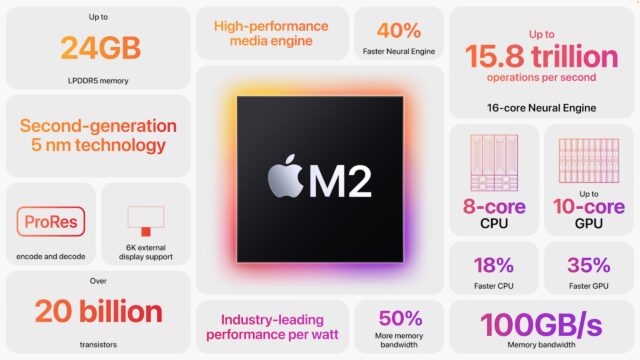
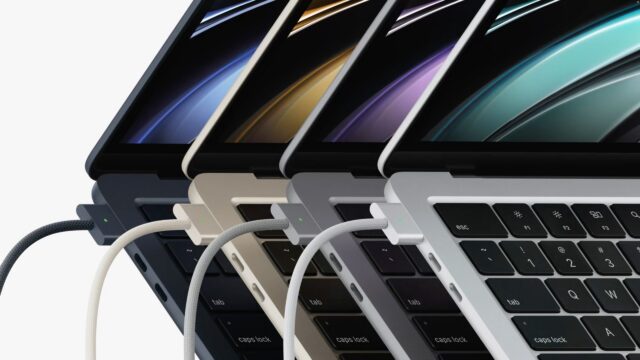
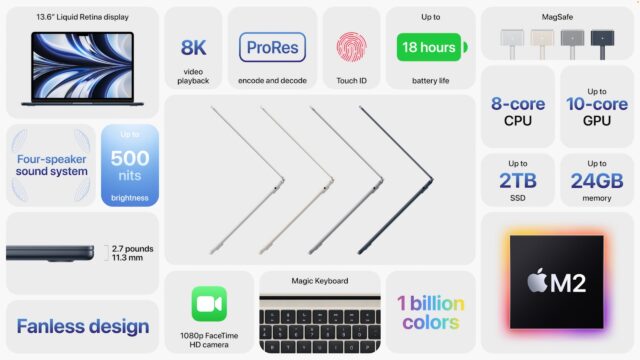
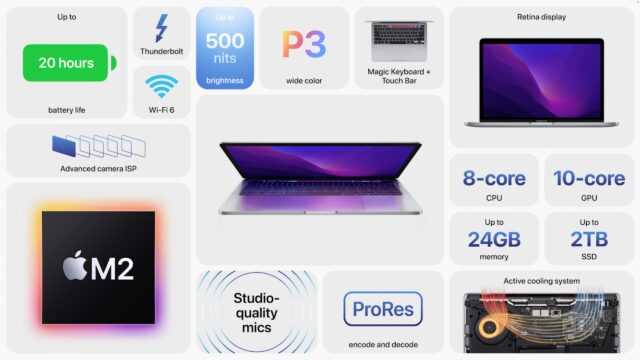
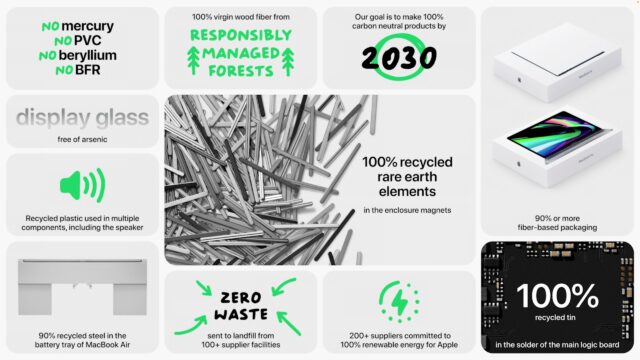
I think it’s worth pointing out that the new MBA is still $100 more expensive than the previous similarly spec’ed MBA. The $999 M1 (7-core GPU) is still around. But previously, if you spec’ed that up to 8-core GPU at 8/256, you ended up at $1099. The M2 with 8/8/8/256 now comes in at that exact same $100 more expensive than base.
So I’d say instead of just replacing old M1 MBAs with new M2 MBAs at the same price points (like what they used to do with Mac), they’re now increasing the price points but leaving around an M1 variant to keep up appearances of retaining the entry level pricing.
The 13" MBP is such an odd product. I really don’t get who is supposed to want it.
The lack of an M2 Mac mini intro today along with the MBA & MBP is a bit concerning. But if I put my optimist hat on, I’d say that must be because Apple is intentionally holding it back. The M1 Mac mini will be replaced with the M2 at the same time as they introduce the high-end M2 Pro/Max Mac mini. Should be before long now. They’re quickly running out of other Macs to transition at this point.
Apple never committed to it across the line, improved it in any way, or convinced developers to support it in interesting ways. And it eliminated the function key row, which a lot of us actually use—I rely heavily on mine and wouldn’t even consider a Touch Bar Mac because of that.
I didn’t have time to check that, but you’re probably right. However, this is an entirely new MacBook Air, with a complete redesign and significantly improved specs beyond the M2 chip. If it’s only $100 more for a bigger, brighter, more colorful screen, 1080p webcam, full-height function key row, and MagSafe 3, along with the M2 performance increases, I’m okay with that.
While I cheer the return of the MagSafe connector, I can’t understand why Apple used the bulky T-style connector instead of the the more svelte and ergonomic L-style connector.
I agree with you, but according to Apple in yesterday’s presentation, it’s the 2nd most popular Mac!!
They should call it the MacBook.
Jason Snell got some time in person with one at Apple Park.
Likely because the L-style connector was incredibly prone to failing from cable stress, and it also somewhat negates one of the main advantages of MagSafe - that an accidental yank of the cord won’t sent the computer flying…
My L-style MagSafe connects pops off if there is a yank on it. The T-style sticks out 1" opposed to the 1/4" of the L-style, plus the latter’s cable goes toward the back while the former’s cable blocks space on the side.
All those things that you list as advantages, also make it less likely to disconnect. Sounds like the threshold for disconnection for the second gen Magsafe 1 was right for you, but presumably not for most since the first gen Magsafe 1, Magsafe 2, and now Magsafe 3 all use the t-shape connector, suggesting that L-shape was a failed experiment.
I had also hoped for a Mini (My i7 mini from 2018 is still doing fine, but I’d love the power from the M2), but perhaps later this fall?
As a developer I would choose the 13" (if I had to carry a laptop) as I hated taking my 15" with my for meetings (back when I used a laptop - now I have a dual mini setup one for home and one at work). When working at my desk (home/work) it would be connected to a large screen and normal keyboard and trackpad.
I don’t work much away from the desk, so a large laptop isn’t really needed for me
Sure, but if you want a Pro that’s smaller than the 15"/16" there’s always the 14". OTOH if you want something lighter and even smaller than that, there’s the MBA. The 13" MBP is really a heavier MBA, with a fan but worse screen. I’d wager if you need that fan to support your heavy-duty workloads over long periods of time w/o throttling, you’d be better off with a Pro/Max (as in the 14" Pro) anyway. I just don’t get who the target of this 13" MBP might be. Last gen at least the screen was comparable to the MBA’s, but now with the Air getting a larger and brighter display, that has vanished as well. This left-over product equipped with a brand new M2 is just so odd. I’d really love to hear how it gets justified at Apple’s executive level. Fly on the wall stuff.
I’d really love to hear how it gets justified at Apple’s executive level. Fly on the wall stuff. 
On a related note…
One Mac that wasn’t unveiled —unlike with the original M1 MBA/MBP intro—was a new M2-based Mac mini. Howard Oakley summarized the M1 launches and compared to M2, extrapolating to a proposed timeline for the remaining Macs.
Bottom line: M2 mini and iMac in fall '22, M2 Pro/Max MBP in spring '23, and M2 Max/Ultra Studio in summer/fall of '23. He’s not certain we’ll actually see a souped-up M2 Mac Pro before the end of the year. And he’s not convinced there will ever be a high-end Mac mini (M2 Pro/Max) to replace the Intel model.
The latter has me a bit concerned, I don’t like the huge gaping hole between the $699 M1 mini and the $1999 Max Studio. On campus we have a lot of systems right in that hole. To leave such a void on the desktop while championing overlap on the portables strikes me as imbalanced, even with portables outselling desktops in mind. Now it’s entirely possible Apple thinks in terms of raw CPU power, even a base M1/M2 can hold up to any existing Intel that would fit the mini thermally, and that is likely true enough. But surrounding limitations like 16GB RAM and 2TB SSD are these days just not acceptable for a number cruncher (or small server) stuffed away in racks and cabinets by the dozens. Sure, that’s not consumer space, but Apple used to be a major player in academic research and I hope they haven’t given up entirely on that.
Thanks, @ace. I value your opinion.
Years ago the rule of thumb was that it took a 20% increase in performance to be noticeable. The M2 is 18% faster than the M1 so it would be noticeable but not significant.
I really find the 24gb of memory to be odd. I would have expected 32 instead.
Sounds like they updated the memory controller from 2-channel to 3-channel. Hence the maximum memory moving from 16GB to 24GB and the maximum memory bandwidth increasing from 66GB/s to 100GB/s.
So first M2 benchmarks have started to leak. If those are correct, they show single-core performance increases by about 12% (in line with a max clock increase from 3.2 GHz in M1 to 3.49 GHz in M2) and multi-core performance gets a 19% boost. Metal gains are more impressive (46%) due to the added 2 GPU cores in M2.
For comparison, single-core this is 9% better than M1 Pro 10/16/16 while multi-core the Pro with its extra 2 cores is still 41% ahead.
While this may seem like it is unimportant, I can’t picture a MacBook Air without its signature wedge shape. I’m really sad to see that’s gone now; its shape immediately differentiated it from other Mac portables. I’ve got an M1 MBA and it’s the last of its kind!
Jason Snell just posted his review of the M2 MacBook Air. It’s almost exactly as I thought.
Quoted from there for emphasis re: throttling.
It seems that a lot of ‘preliminary warning’ about throttling issues were rather overblown. The Cinebench 10-min test scores for M2 MBA is less than 5% lower than the single-run score, compared to close to 10% for M1 MBA. (In addition, I don’t think a typical MBA user will run extended loads on regular basis so it is probably a non-issue in the first place.)
Separately, I was also quite pleased that the new design team opted for a clean, simple, “honest” design* language as compared to the tapered design of the previous MBA/MBP designs. Quite surprising considering that honest design is one of the values advocated by Dieter Rams, who inspired Jony Ive; yet it took the new team to realise this.
*Another subtle point about honest design is living up to promises, quoting Dieter Rams: “Good design is honest. It does not make a product more innovative, powerful or valuable than it really is. It does not attempt to manipulate the consumer with promises that cannot be kept.” - Tenuous at best when Intel chips were used, esp. inside MBPs.
I ordered my M2 MBA last week, due to ship to my nearest Apple Store for pickup on August 9. I’m very happy with that review. I’ll never use it for anything that stressful, and I hope this one lasts me a good long time. My current portable Mac that I use most of the time is a 2015 MBA with 8 GB RAM so this will be a dramatic increase in performance.
John Gruber has another glowing review at Daring Fireball.
Like John Gruber, my main Mac is a 14" MBP and like him I see how this new M2 MBA is really getting very close to being what the ideal Mac should be.
Also like him, one of the only things I’d change about this MBA if I could would be port placement.
I’m really anxious to see what Apple will do in terms of M2 Pro/Max 14" MBP refresh. I have to admit, seeing how much smaller and lighter this MBA is, and how the M2 performs so incredibly well, I’d be very tempted to swap this 14" (to me its card slots are all but useless) for a new M2 MBA. Not that the 14" MBP isn’t great (it is!), but this new MBA is just all-around so great, it’s one heck of a temptation. IMHO probably one of the greatest portable Macs we’ve ever seen.